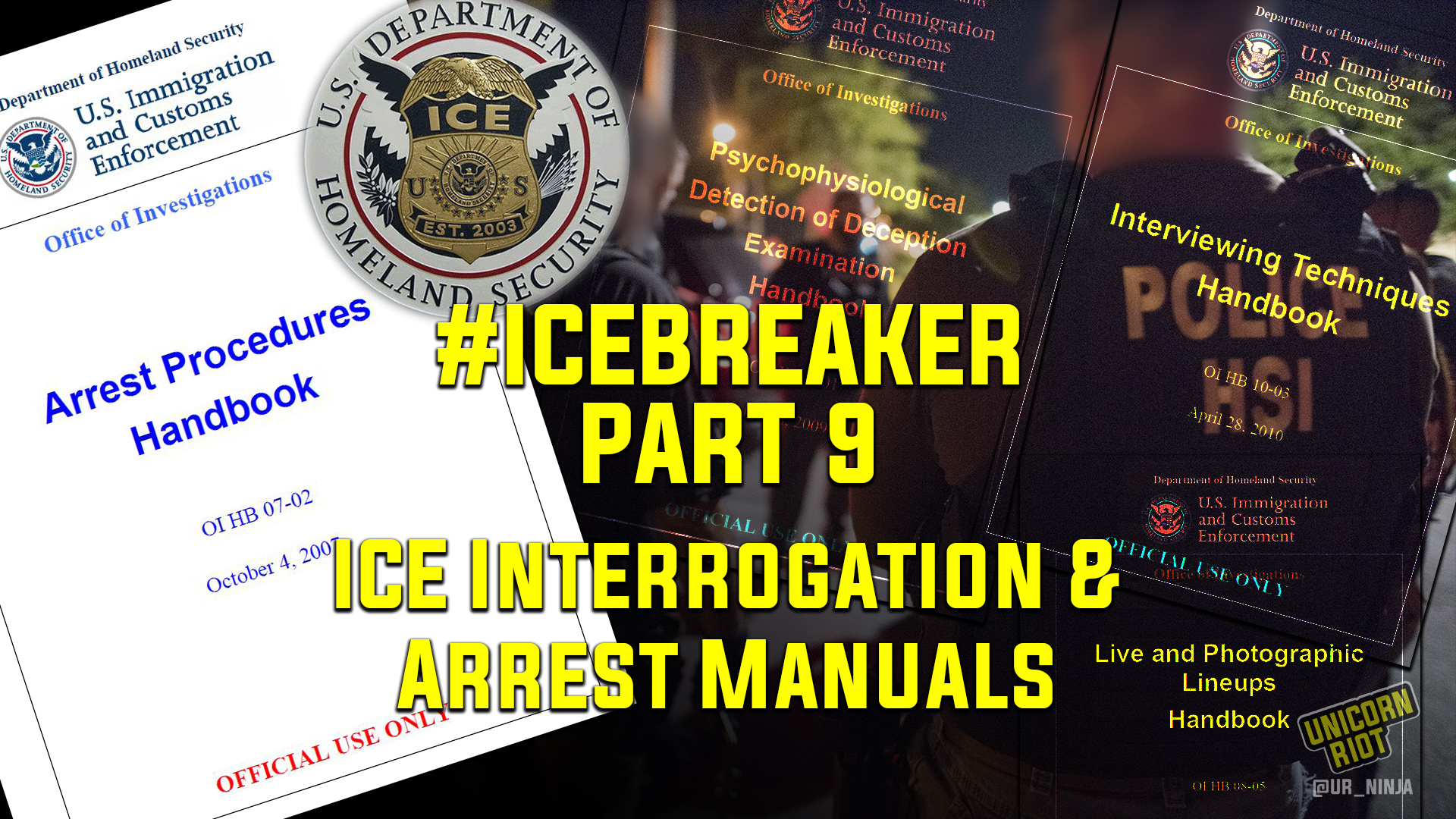Icebreaker Pt 9 – Leaked Interrogation and Arrest ICE Manuals
United States – Unicorn Riot obtained confidential Immigration and Customs Enforcement agent policy manuals. Icebreaker part 9 covers several handbooks: arrest procedures, interviewing techniques, live and photographic lineups, and psychophysiological detection of deception (also known as polygraphs).
These relatively brief manuals provide key details about how agents working within ICE process arrests and interrogate suspects. These manuals were published for Homeland Security Investigations (HSI) special agents.
HSI is one of two major sections within ICE. According to the agency, HSI has more than 10,000 employees including 7,000 special agents at 30 main field offices led by “special agents in charge” (SACs) around the United States, 182 other field offices and 69 overseas locations. Those agents would be expected to be familiar with the manuals in this series of reports. (By comparison, in 2018 the FBI had roughly 14,000 special agents.)
ICE’s other main section is Enforcement and Removal Operations (ERO), which is aimed more narrowly at immigrants. HSI has a large investigative portfolio similar to the FBI, but also assists ERO-led operations. HSI was created by merging parts of other agencies such as the investigative sections of the US Customs Service (USCS) and Immigration and Naturalization Service (INS) when the Department of Homeland Security was organized in 2003. HSI was initially called the “Office of Investigations” (OI) inside ICE, so many manuals in our Icebreaker releases are peppered with “OI” references as well as references to older USCS policies.
While these manuals were published during the Bush and Obama administrations, a FOIA request by GovernmentAttic.org shows that some of the manuals were still considered current policy at the end of 2016, while others were replaced.
All page numbers here are PDF pages, not the pagination printed on the footer.
#Icebreaker Series - Unicorn Riot series on ICE policy manuals
- Icebreaker Pt 1 – Secret Homeland Security ICE/HSI Manual for Stripping US Citizenship (Feb. 14, 2018)
- Icebreaker Pt 2 – Confidential Homeland Security Asset Forfeiture and Search and Seizure Handbooks (Feb. 22, 2018)
- Icebreaker Pt 3 – Confidential Homeland Security Fugitive and Compliance Enforcement Handbooks (Feb. 28, 2018)
- Icebreaker Pt 4 – Homeland Security Special Agent On-the-Job Training Manual (Apr. 27, 2018)
- Icebreaker Pt 5 – Confidential Homeland Security Undercover Operations Handbook (Jun. 22, 2018)
- Icebreaker Pt 6 – Leaked ICE Special Response Team Handbook for Planning and Executing Armed Raids (Sept. 18, 2019)
- Icebreaker Pt 7 - ICE Case Management Handbook Based on Federal Law Enforcement "System of Systems” (Dec. 13, 2019)
- Icebreaker Pt 8 – Leaked ICE Handbooks for T and U Visa Application Investigations (Dec. 18, 2019)
- Icebreaker Pt 9 – Leaked Interrogation and Arrest ICE Manuals (Jan. 1, 2020)
- Icebreaker Pt 10 – Leaked ICE Agent Private Bill and Commercial Trade Fraud Investigation Handbooks (Jan. 4, 2020)
- Icebreaker Pt 11 – Bush/Clinton Era Customs Investigators Manuals (Feb. 13, 2020)
Interviewing Techniques Handbook
ice-hsi-interviewing-techniques
At 46 pages, this manual replaces the manuals from US Customs Service and Immigration and Naturalization Service (INS). Much of the manual, starting on PDF page 26, focuses on the various interrogation techniques including logical, sympathetic, indifferent, face saving, egotistical, exaggeration, indirect, direct, non-directive, and controlled answer.
Download the manual directly here. This 2010-vintage manual was still active policy at the end of 2016 according to a FOIA by GovernmentAttic.org.
p6: Introduction, purpose and scope. Notes that lots of ICE staff can conduct “informational” interviews.
p7: Responsibilities and definitions.
p9-15: Legal considerations, Miranda warnings, statement of rights, right to attorney.
p16-18: Preparing for the interview and how to structure field notes.
p18: Conducting interviews.
p19: Establishing credibility including reasons why informants and people “enamored with law enforcement” “color or distort the information provided”, also poor memory, strong emotion, “constant repetition of ideas and mental images” which get conflated with facts
p20: Establish rapport, questioning the witness “Once the SAs have the witness in a communicative mood”. “SAs will find that, on many occasions, it is not what a witness says that is important, but the manner in which he or she says it, or what he or she does not say that is truly important.”
p21: “Sudden silence on the part of the witness may indicate deliberation as to whether he or she should share information with the SAs. Uncertainty or sudden confusion may indicate that a sensitive area has been reached.”
p22-23: Interviewing informants and propping up their morale: “Sympathize with the informant about any personal difficulties he or she may be experiencing, particularly if they affect his or her performance as an informant.” Also not leaking to informants: “SAs must be careful not to reveal their own knowledge through the phrasing of their questions.” “Informants may be motivated by revenge, jealousy, or the need for money, but, whatever the reason, when SAs end an interview with an informant, they should make it clear […] they value the help…”
p23: Interviewing suspects and custodial interviews
p24: Interviewing juveniles including when detained. “SAs operating in the Ninth Circuit must also give the parents the opportunity to speak with the juvenile if they request it.”
p25: Denaturalization and criminal records elements of interviews. See Icebreaker Pt 1 for more on denaturalization.
p26-29: Interviewing techniques include logical, sympathetic, indifferent, face saving, egotistical, exaggeration, indirect, direct, non-directive, and controlled answer. “Indifference is best used by in combination with a contrasting style that is exhibited by a different SA.”
p27: Face-saving: “SAs attempt to provide the individual with a psychological ‘way out’ that will justify his or her participation in the crime. It is implied, but never stated, that a thorough understanding of the individual’s motivation may affect his or her degree of responsibility for the criminal activity.”
p27: Egotistical: “SAs should talk about the intelligence required to work out, for example, complex drug or human smuggling operations. SAs should pretend to be impressed”.
p27: Exaggeration: “SAs may elect to exaggerate the charges that can possibly be brought against the individual. For example, SAs may suggest that they believe the individual is a much bigger smuggler than is actually the case.” Note this is an good example of how federal agents can freely lie in an interview, and are directed to do so here but if the reverse occurs it is a crime.
p29: Admissions and confessions. The difference “can be perplexing”.
p30-31: Symptoms of deception. Vocal changes like speech rate, volume, pitch, dryness, restlessness, sweating, avoiding eye contact, excessive assertions of truthfulness. Also diversions called “false issues”.
p31-33: Use of interpreters and problems with interpreters.
p34: Coercion or duress. There should be a witness at any interview to deter claims of coercion or duress. “…[N]o time limit is placed on an interview, no one should be subjected to questioning for so long a period or under such adverse conditions that it may constitute coercion or duress.” Nothing here discusses the role of mistreatment when someone is under arrest though.
p34: Interview locations.
p35: Call-in letters regarding immigration issues and electronic recording of interviews.
p28-44: Sworn Statements, their formatting and avoiding challenges.
p45-46: Appendix – Acronyms.
Live and Photographic Lineups Handbook
This 22-page, 2008-vintage manual was still active policy at the end of 2016 according to a FOIA from GovernmentAttic.org. It covers a long-standing feature of police investigations, lineups of people and photographs to see if a witness spots a resemblance to a suspect.
Download the manual directly here.
ice-hsi-lineups
p2: The handbook replaces the policies of the US Customs Service (USCS) and Immigration and Naturalization Service (INS).
p5: A “filler” is a non-suspect used to complete or “fill in” a lineup.
p6: Steps of a lineup, instructing the witness.
p6-7: Right to counsel for people in a lineup.
p7: Procedure for conducting lineups – first the photographic type.
p7: “Consider that complete uniformity of features is not required. Avoid using fillers who so closely resemble the suspect that a person familiar with the suspect might find it difficult to distinguish the suspect from the fillers.”
p8: In a live lineup, “Select fillers who generally fit the witness’ physical description of the suspect.”
p9-13: Instructing the witness and recordkeeping after the lineup.
p14: Appendix A: the form for advisement of right to counsel and waiver and consent declaration.
p15-19: Appendix B: Live or Photographic Lineup Display instructions sheet ICE Form I-378 (10/08).
p20-21: Appendix C: Witness Identification Response.
p22: Appendix D: Acronyms.
Psychophysiological Detection of Deception Examination Handbook
The Psychophysiological Detection of Deception Examination Handbook issued June 8, 2009, is 18 pages covering how to work with polygraphs (‘lie detectors’). This manual appears to have been replaced with a “Polygraph Examinations Handbook” in 2016 according to a FOIA from GovernmentAttic.org.
The American Psychological Association warns that “most psychologists agree that there is little evidence that polygraph tests can accurately detect lies.” Nonetheless, investigators in the federal government have used various types of polygraph-based interrogations for decades.
Download the manual directly here.
ice-hsi-psychophysiological-indicatorsp5: “PDD is a term that describes methodologies or processes that analyze an individual’s physiology in an attempt to determine if that individual is concealing the truth”. They have high confidence: “Under the control of a competent and ethical PDD Examiner, the PDD Examination is highly reliable in detecting deception or verifying the truth[…]”
p6: Glossary and summary of physiological effects of attempting deception.
p7: Qualifications of PDD examiners.
p8: Internship program to become Certified PDD Examiner
p9: Demonstration of continued proficiency. “Political beliefs and organizational affiliations of a non-subversive nature” “shall not be examined”. The nature of “subversive” is undefined here.
p10-13: Levels of responsibility from the Director of the Office of Investigations to the examiners.
p13-15: Procedures. How these exams are requested, conducted “in compliance with the provisions of this Handbook, the Federal Examiner Polygraph Handbook”, and quality control.
p14: “An ICE PDD Examiner’s opinion regarding the veracity of a PDD Examinee must be based on an evaluation of the respiration and electrodermal and cardiovascular physiology recorded[…]”
p16-17: Appendix A: Request for Psychophysiological Detection of Deception Information. The forms are submitted to “[email protected]”
p18: Acronyms.
Arrest Procedure Handbook
This 2007-vintage 24-page arrest procedure handbook was replaced in 2015 by another version, according to a FOIA from GovernmentAttic.org. Download the manual directly here.
ice-hsi-arrest-procedure
p2: This manual replaces INS and USCS manuals.
p6: “The arrest, detention, and transportation of individuals are among the most dangerous duties”. Following the manual “can also preclude costly and time-consuming lawsuits or trial tactics that might divert the attention of courts and juries”.
p7: Definitions. “For the purposes of this Handbook, an ‘individual in custody’ may not necessarily be ‘in custody’ for Miranda purposes.”
p9: In some states HSI agents are also deputized as state peace officers. Also HSI agents may perform “citizen’s arrest” for matters outside ICE jurisdiction.
p10-12: Types of arrests including diplomatic immunity detentions.
p12-13: Arrest procedures including foot pursuits, criminal and administrative arrests (eg immigration violations).
p13-15: Methods and types of physical restraints.
p16: Complete searches and prisoners allowed to give all property to a third party.
p17: People not subject to arrest include diplomats and family members, sitting judges while court is in session; members of Congress during sessions or while traveling to and from sessions can be arrested but not otherwise detained. Foreign nationals have the right to speak to their consular officer.
p18: Miranda warnings (right to attorney, right to remain silent and so on). “Once an individual has requested an attorney, the interrogation must cease immediately and the individual may not be interrogated about the case until after conferring with counsel or if the individual in custody otherwise initiates further conversation.”
p19: Notice of rights warnings following administrative arrests (detained immigrants). Also in this section arrests and administrative detention of juveniles. Juveniles should be held in accordance with the Flores v. Reno Settlement Agreement, a significant part of current U.S. immigration law.
p20-23: “Transporting an individual can be one of the most dangerous undertakings that SAs will encounter. The hazards and problems that one may encounter are countless.” Other details about how agents are supposed to accompany arrestees. With “high-risk individuals” “Belly chains and leg irons should be employed in addition to handcuffs”.
p23: “Prior to initiating the transport, SAs must provide the National Law Enforcement Communications Center (NLECC) in Orlando, Florida, also known as Charlie 100, with the following information via a mobile radio or by calling 1-800-X-SECTOR (SAs assigned to the SAC San Juan office in Puerto Rico are required to use their mobile radio or call the SAC San Juan Communications Center, also known as Charlie 2000, at 1-800-981-3030)”.
p24: Acronyms.
#Icebreaker Series - Unicorn Riot series on ICE policy manuals
- Icebreaker Pt 1 – Secret Homeland Security ICE/HSI Manual for Stripping US Citizenship (Feb. 14, 2018)
- Icebreaker Pt 2 – Confidential Homeland Security Asset Forfeiture and Search and Seizure Handbooks (Feb. 22, 2018)
- Icebreaker Pt 3 – Confidential Homeland Security Fugitive and Compliance Enforcement Handbooks (Feb. 28, 2018)
- Icebreaker Pt 4 – Homeland Security Special Agent On-the-Job Training Manual (Apr. 27, 2018)
- Icebreaker Pt 5 – Confidential Homeland Security Undercover Operations Handbook (Jun. 22, 2018)
- Icebreaker Pt 6 – Leaked ICE Special Response Team Handbook for Planning and Executing Armed Raids (Sept. 18, 2019)
- Icebreaker Pt 7 - ICE Case Management Handbook Based on Federal Law Enforcement "System of Systems” (Dec. 13, 2019)
- Icebreaker Pt 8 – Leaked ICE Handbooks for T and U Visa Application Investigations (Dec. 18, 2019)
- Icebreaker Pt 9 – Leaked Interrogation and Arrest ICE Manuals (Jan. 1, 2020)
- Icebreaker Pt 10 – Leaked ICE Agent Private Bill and Commercial Trade Fraud Investigation Handbooks (Jan. 4, 2020)
- Icebreaker Pt 11 – Bush/Clinton Era Customs Investigators Manuals (Feb. 13, 2020)
Please consider a tax-deductible donation to help sustain our horizontally-organized, non-profit media organization:



